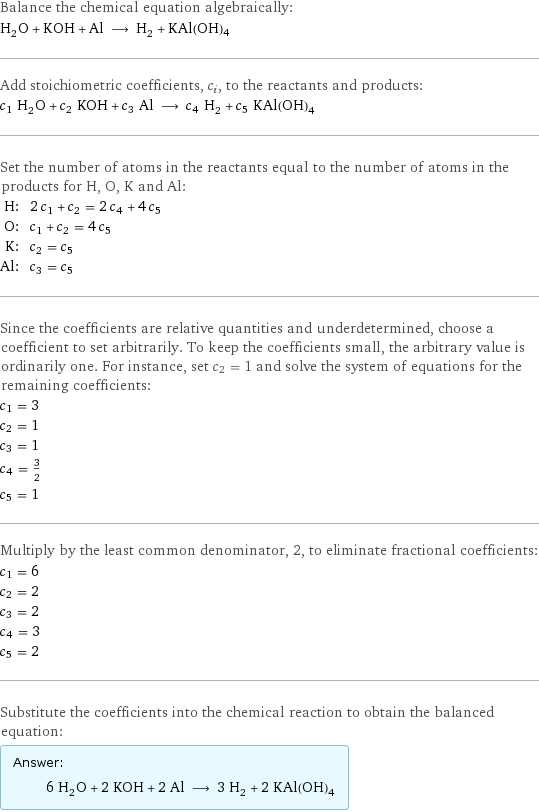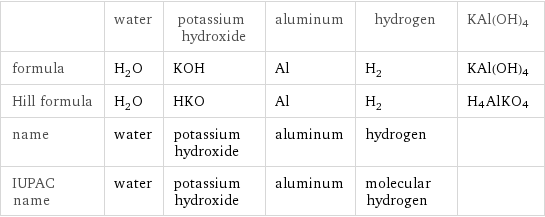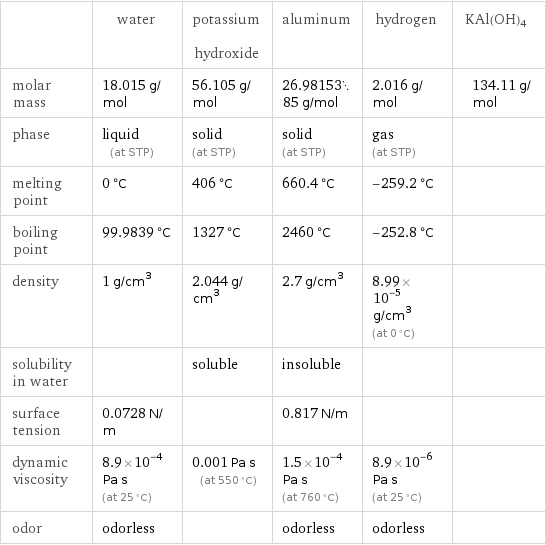Input interpretation

H_2O water + KOH potassium hydroxide + Al aluminum ⟶ H_2 hydrogen + KAl(OH)4
Balanced equation

Balance the chemical equation algebraically: H_2O + KOH + Al ⟶ H_2 + KAl(OH)4 Add stoichiometric coefficients, c_i, to the reactants and products: c_1 H_2O + c_2 KOH + c_3 Al ⟶ c_4 H_2 + c_5 KAl(OH)4 Set the number of atoms in the reactants equal to the number of atoms in the products for H, O, K and Al: H: | 2 c_1 + c_2 = 2 c_4 + 4 c_5 O: | c_1 + c_2 = 4 c_5 K: | c_2 = c_5 Al: | c_3 = c_5 Since the coefficients are relative quantities and underdetermined, choose a coefficient to set arbitrarily. To keep the coefficients small, the arbitrary value is ordinarily one. For instance, set c_2 = 1 and solve the system of equations for the remaining coefficients: c_1 = 3 c_2 = 1 c_3 = 1 c_4 = 3/2 c_5 = 1 Multiply by the least common denominator, 2, to eliminate fractional coefficients: c_1 = 6 c_2 = 2 c_3 = 2 c_4 = 3 c_5 = 2 Substitute the coefficients into the chemical reaction to obtain the balanced equation: Answer: | | 6 H_2O + 2 KOH + 2 Al ⟶ 3 H_2 + 2 KAl(OH)4
Structures

+ + ⟶ + KAl(OH)4
Names

water + potassium hydroxide + aluminum ⟶ hydrogen + KAl(OH)4
Equilibrium constant
![Construct the equilibrium constant, K, expression for: H_2O + KOH + Al ⟶ H_2 + KAl(OH)4 Plan: • Balance the chemical equation. • Determine the stoichiometric numbers. • Assemble the activity expression for each chemical species. • Use the activity expressions to build the equilibrium constant expression. Write the balanced chemical equation: 6 H_2O + 2 KOH + 2 Al ⟶ 3 H_2 + 2 KAl(OH)4 Assign stoichiometric numbers, ν_i, using the stoichiometric coefficients, c_i, from the balanced chemical equation in the following manner: ν_i = -c_i for reactants and ν_i = c_i for products: chemical species | c_i | ν_i H_2O | 6 | -6 KOH | 2 | -2 Al | 2 | -2 H_2 | 3 | 3 KAl(OH)4 | 2 | 2 Assemble the activity expressions accounting for the state of matter and ν_i: chemical species | c_i | ν_i | activity expression H_2O | 6 | -6 | ([H2O])^(-6) KOH | 2 | -2 | ([KOH])^(-2) Al | 2 | -2 | ([Al])^(-2) H_2 | 3 | 3 | ([H2])^3 KAl(OH)4 | 2 | 2 | ([KAl(OH)4])^2 The equilibrium constant symbol in the concentration basis is: K_c Mulitply the activity expressions to arrive at the K_c expression: Answer: | | K_c = ([H2O])^(-6) ([KOH])^(-2) ([Al])^(-2) ([H2])^3 ([KAl(OH)4])^2 = (([H2])^3 ([KAl(OH)4])^2)/(([H2O])^6 ([KOH])^2 ([Al])^2)](../image_source/90f5211fc15b345c928352110844d53d.png)
Construct the equilibrium constant, K, expression for: H_2O + KOH + Al ⟶ H_2 + KAl(OH)4 Plan: • Balance the chemical equation. • Determine the stoichiometric numbers. • Assemble the activity expression for each chemical species. • Use the activity expressions to build the equilibrium constant expression. Write the balanced chemical equation: 6 H_2O + 2 KOH + 2 Al ⟶ 3 H_2 + 2 KAl(OH)4 Assign stoichiometric numbers, ν_i, using the stoichiometric coefficients, c_i, from the balanced chemical equation in the following manner: ν_i = -c_i for reactants and ν_i = c_i for products: chemical species | c_i | ν_i H_2O | 6 | -6 KOH | 2 | -2 Al | 2 | -2 H_2 | 3 | 3 KAl(OH)4 | 2 | 2 Assemble the activity expressions accounting for the state of matter and ν_i: chemical species | c_i | ν_i | activity expression H_2O | 6 | -6 | ([H2O])^(-6) KOH | 2 | -2 | ([KOH])^(-2) Al | 2 | -2 | ([Al])^(-2) H_2 | 3 | 3 | ([H2])^3 KAl(OH)4 | 2 | 2 | ([KAl(OH)4])^2 The equilibrium constant symbol in the concentration basis is: K_c Mulitply the activity expressions to arrive at the K_c expression: Answer: | | K_c = ([H2O])^(-6) ([KOH])^(-2) ([Al])^(-2) ([H2])^3 ([KAl(OH)4])^2 = (([H2])^3 ([KAl(OH)4])^2)/(([H2O])^6 ([KOH])^2 ([Al])^2)
Rate of reaction
![Construct the rate of reaction expression for: H_2O + KOH + Al ⟶ H_2 + KAl(OH)4 Plan: • Balance the chemical equation. • Determine the stoichiometric numbers. • Assemble the rate term for each chemical species. • Write the rate of reaction expression. Write the balanced chemical equation: 6 H_2O + 2 KOH + 2 Al ⟶ 3 H_2 + 2 KAl(OH)4 Assign stoichiometric numbers, ν_i, using the stoichiometric coefficients, c_i, from the balanced chemical equation in the following manner: ν_i = -c_i for reactants and ν_i = c_i for products: chemical species | c_i | ν_i H_2O | 6 | -6 KOH | 2 | -2 Al | 2 | -2 H_2 | 3 | 3 KAl(OH)4 | 2 | 2 The rate term for each chemical species, B_i, is 1/ν_i(Δ[B_i])/(Δt) where [B_i] is the amount concentration and t is time: chemical species | c_i | ν_i | rate term H_2O | 6 | -6 | -1/6 (Δ[H2O])/(Δt) KOH | 2 | -2 | -1/2 (Δ[KOH])/(Δt) Al | 2 | -2 | -1/2 (Δ[Al])/(Δt) H_2 | 3 | 3 | 1/3 (Δ[H2])/(Δt) KAl(OH)4 | 2 | 2 | 1/2 (Δ[KAl(OH)4])/(Δt) (for infinitesimal rate of change, replace Δ with d) Set the rate terms equal to each other to arrive at the rate expression: Answer: | | rate = -1/6 (Δ[H2O])/(Δt) = -1/2 (Δ[KOH])/(Δt) = -1/2 (Δ[Al])/(Δt) = 1/3 (Δ[H2])/(Δt) = 1/2 (Δ[KAl(OH)4])/(Δt) (assuming constant volume and no accumulation of intermediates or side products)](../image_source/a94480d1dbf42f778a07adc3c125a3ed.png)
Construct the rate of reaction expression for: H_2O + KOH + Al ⟶ H_2 + KAl(OH)4 Plan: • Balance the chemical equation. • Determine the stoichiometric numbers. • Assemble the rate term for each chemical species. • Write the rate of reaction expression. Write the balanced chemical equation: 6 H_2O + 2 KOH + 2 Al ⟶ 3 H_2 + 2 KAl(OH)4 Assign stoichiometric numbers, ν_i, using the stoichiometric coefficients, c_i, from the balanced chemical equation in the following manner: ν_i = -c_i for reactants and ν_i = c_i for products: chemical species | c_i | ν_i H_2O | 6 | -6 KOH | 2 | -2 Al | 2 | -2 H_2 | 3 | 3 KAl(OH)4 | 2 | 2 The rate term for each chemical species, B_i, is 1/ν_i(Δ[B_i])/(Δt) where [B_i] is the amount concentration and t is time: chemical species | c_i | ν_i | rate term H_2O | 6 | -6 | -1/6 (Δ[H2O])/(Δt) KOH | 2 | -2 | -1/2 (Δ[KOH])/(Δt) Al | 2 | -2 | -1/2 (Δ[Al])/(Δt) H_2 | 3 | 3 | 1/3 (Δ[H2])/(Δt) KAl(OH)4 | 2 | 2 | 1/2 (Δ[KAl(OH)4])/(Δt) (for infinitesimal rate of change, replace Δ with d) Set the rate terms equal to each other to arrive at the rate expression: Answer: | | rate = -1/6 (Δ[H2O])/(Δt) = -1/2 (Δ[KOH])/(Δt) = -1/2 (Δ[Al])/(Δt) = 1/3 (Δ[H2])/(Δt) = 1/2 (Δ[KAl(OH)4])/(Δt) (assuming constant volume and no accumulation of intermediates or side products)
Chemical names and formulas

| water | potassium hydroxide | aluminum | hydrogen | KAl(OH)4 formula | H_2O | KOH | Al | H_2 | KAl(OH)4 Hill formula | H_2O | HKO | Al | H_2 | H4AlKO4 name | water | potassium hydroxide | aluminum | hydrogen | IUPAC name | water | potassium hydroxide | aluminum | molecular hydrogen |
Substance properties

| water | potassium hydroxide | aluminum | hydrogen | KAl(OH)4 molar mass | 18.015 g/mol | 56.105 g/mol | 26.9815385 g/mol | 2.016 g/mol | 134.11 g/mol phase | liquid (at STP) | solid (at STP) | solid (at STP) | gas (at STP) | melting point | 0 °C | 406 °C | 660.4 °C | -259.2 °C | boiling point | 99.9839 °C | 1327 °C | 2460 °C | -252.8 °C | density | 1 g/cm^3 | 2.044 g/cm^3 | 2.7 g/cm^3 | 8.99×10^-5 g/cm^3 (at 0 °C) | solubility in water | | soluble | insoluble | | surface tension | 0.0728 N/m | | 0.817 N/m | | dynamic viscosity | 8.9×10^-4 Pa s (at 25 °C) | 0.001 Pa s (at 550 °C) | 1.5×10^-4 Pa s (at 760 °C) | 8.9×10^-6 Pa s (at 25 °C) | odor | odorless | | odorless | odorless |
Units
